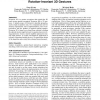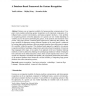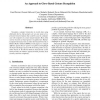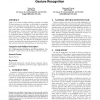143
Voted
WACV
2012
IEEE
13 years 7 months ago
2012
IEEE
A convenient way of analysing Riemannian manifolds is to embed them in Euclidean spaces, with the embedding typically obtained by flattening the manifold via tangent spaces. This...
115
Voted
MMSYS
2012
13 years 7 months ago
2012
Motion-based control is gaining popularity, and motion gestures form a complementary modality in human-computer interactions. To achieve more robust user-independent motion gestur...
112
click to vote
IUI
2012
ACM
13 years 7 months ago
2012
ACM
One Feature (1F) is a simple and intuitive pruning strategy that reduces considerably the amount of computations required by Nearest-Neighbor gesture classifiers while still pres...
109
Voted
IUI
2012
ACM
13 years 7 months ago
2012
ACM
In this paper we present a new bimanual markerless gesture interface for 3D full-body motion tracking sensors, such as the Kinect. Our interface uses a probabilistic algorithm to ...
105
Voted
IUI
2011
ACM
14 years 3 months ago
2011
ACM
In this paper, we present a new type of Marking menus. Continuous Marking Menus are specifically dedicated to penbased interfaces, and designed to define a set of cursive, reali...
157
click to vote
IUI
2011
ACM
14 years 3 months ago
2011
ACM
Protractor 3D is a gesture recognizer that extends the 2D touch screen gesture recognizer Protractor [8] to 3D gestures. It inherits many of Protractor’s desirable properties, s...
120
Voted
PUC
2010
14 years 7 months ago
2010
Abstract Gestures are an important modality for human-machine communication. Computer vision modules performing gesture recognition can be important components of intelligent homes...
144
Voted
CORR
2010
Springer
14 years 9 months ago
2010
Springer
Gesture recognition is mainly apprehensive on analyzing the functionality of human wits. The main goal of gesture recognition is to create a system which can recognize specific hu...
104
click to vote
HCI
2009
14 years 10 months ago
2009
Nowadays, computer interaction is mostly done using dedicated devices. But gestures are an easy mean of expression between humans that could be used to communicate with computers ...
127
Voted
ICMI
2010
Springer
14 years 10 months ago
2010
Springer
Using a new hand tracking technology capable of tracking 3D hand postures in real-time, we developed a recognition system for continuous natural gestures. By natural gestures, we ...




